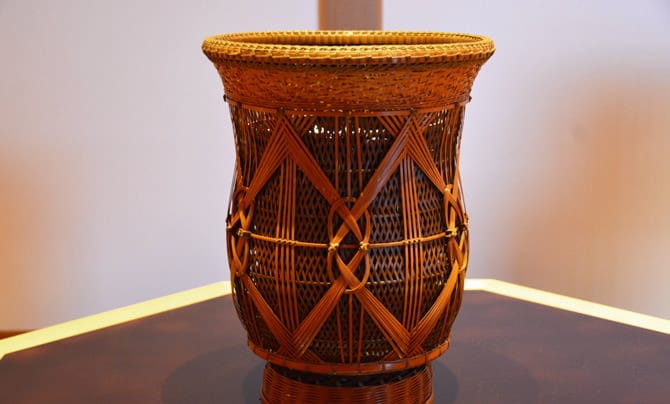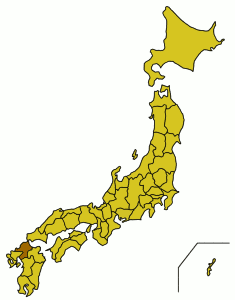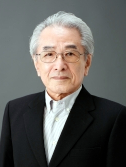|
List Of Living National Treasures Of Japan (crafts)
This list of Living National Treasures of Japan (crafts) contains all the individuals and groups certified as Living National Treasures by the Ministry of Education, Culture, Sports, Science and Technology of the government of Japan in the category of the . Crafts are divided into eight categories: pottery, textiles, lacquerware, metalworking, dollmaking, woodworking, papermaking, and other. The categories are subdivided into a number of more specific subcategories. Those working in crafts are eligible for recognition either individually (Individual Certification) or as part of a group (Preservation Group Certification). List of current designated individuals (crafts) Ceramics Textiles Lacquerware Metalworking Dollmaking Woodworking Papermaking List of past designated individuals (crafts) Ceramics Textiles Lacquerware Metalworking Dollmaking Woodworking Other Papermaking Papermaking is the manufacture of paper and cardboard, which are u ... [...More Info...] [...Related Items...] OR: [Wikipedia] [Google] [Baidu] |
Living National Treasures Of Japan
is a Japanese popular term for those individuals certified as by the MEXT, Minister of Education, Culture, Sports, Science and Technology as based on Japan's . The term "Living National Treasure" is not formally mentioned in the law, but is an informal term referencing the cultural properties designated as the National Treasure (Japan), National Treasures. The Japanese government provides a subsidy of 2 million yen per person per year for Living National Treasures. The total amount of the subsidy is determined by the national budget, and since 2002 it has been 232 million yen. Therefore, the number of Living National Treasures in existence is a maximum of 116, and if there are 116 Living National Treasures, no person with any outstanding skills will be newly designated as a Living National Treasure unless a vacancy occurs due to death. [...More Info...] [...Related Items...] OR: [Wikipedia] [Google] [Baidu] |
Ito Sekisui V
is a Japanese potter. Ito Sekisui V is the 14th generation of his family to follow a long tradition of ceramic work. He was given the birth name Yoichi Ito, the first character of his name ("''yo''" ) being the Japanese word for "kiln". After his father Ito Sekisui IV's death (when Yoichi was 19), he studied ceramics at Kyoto University , or , is a National university, national research university in Kyoto, Japan. Founded in 1897, it is one of the former Imperial Universities and the second oldest university in Japan. The university has ten undergraduate faculties, eighteen gra .... After graduating in 1966, he returned to his home town of Sado to continue the family business. His work was displayed at the Traditional Arts and Crafts Exhibition in 1972. In 1973, he won first prize at the second Japan Ceramic Art Exhibition. In the 1980s, Sekisui V started to create '' neriage'' works as well as his family's traditional ''mumyoi-yaki'' pieces and, in 2003, he was appointed a ... [...More Info...] [...Related Items...] OR: [Wikipedia] [Google] [Baidu] |
Woodworking
Woodworking is the skill of making items from wood, and includes cabinetry, furniture making, wood carving, joinery, carpentry, and woodturning. History Along with stone, clay and animal parts, wood was one of the first materials worked by early humans. Microwear analysis of the Mousterian stone tools used by the Neanderthals show that many were used to work wood. The development of civilization was closely tied to the development of increasingly greater degrees of skill in working these materials. Among the earlliest finds of woodworking are shaped sticks displaying notches from Kalambo Falls in southen Africa, dating to around 476,000 years ago. The Clacton spearhead from Clacton-on-Sea, England, dating to around 400,000 years ago,Allington-Jones, L., (2015) ''Archaeological Journal'', 172 (2) 273–296 The Clacton Spear – The Last One Hundred Years the Schöningen spears, from Schöningen (Germany) dating around 300,000 years ago and the Lehringen spear from no ... [...More Info...] [...Related Items...] OR: [Wikipedia] [Google] [Baidu] |
Japanese Traditional Dolls
are one of the traditional Japanese crafts. There are various types of traditional dolls, some representing children and babies, some the imperial court, warriors and heroes, fairy-tale characters, gods and (rarely) demons, and also people of the daily life of Japanese cities. Many have a long tradition and are still made today for household shrines, formal gift-giving, or for festival celebrations such as , the doll festival, or , Children's Day. Some are manufactured as a local craft, to be purchased by pilgrims as a souvenir of a temple visit or some other trip. History There may be a continuity in the making of the , humanoid figures, by the ancient Jōmon period, Jōmon culture in Japan (8000–200 BC), which were associated with fertility or shamanism, shamanistic rites, at a time when dolls were thought to have souls. Dolls also have continuity from the funerary figures of the subsequent Kofun period, Kofun culture (around 300–600 AD). Expert Alan Pate notes that te ... [...More Info...] [...Related Items...] OR: [Wikipedia] [Google] [Baidu] |
Toreutics
The term ''toreutics'', relatively rarely used in English, refers to artistic metalworking – hammering gold or silver (or other materials), engraving, or using repoussé and chasing to form minute detailed reliefs or small engraved patterns. Toreutics can include metal-engraving – forward-pressure linear metal removal with a burin. Toreutics is extremely ancient, and depending on the metal used will survive burial for periods of centuries better than art in many other materials. Conversely if above ground it was likely to be melted down and the metal reused. Until the Middle Ages it was also among the art forms with the highest prestige. Archeological background It was practised in the Bronze Age and was well established centuries before the shaft graves. Toureutic items of special quality from the Iron Age are the Certosa situla from Italy and from Slovenia the Vače situla and the Vače belt-plate. Toreutics flourished to an unusual degree among the peoples of Asia Mi ... [...More Info...] [...Related Items...] OR: [Wikipedia] [Google] [Baidu] |
Yukie Osumi
Yukie Osumi (born 1945; ) is a Japanese metalsmith. In 2015, she became the first woman in her field to be named a Living National Treasure of Japan. Biography Yukie Osumi was born in Kakegawa, Shizuoka Prefecture, in 1945. She studied art history at Tokyo University of the Arts, graduating in 1969. When Osumi began metalworking, very few Japanese women were involved in the field. However, she gained the support of mentors such as the well-known metalsmiths Shiro Sekiya and Moriyuki Katsura, the latter of whom granted her her first apprenticeship. After many years of pursuing her craft while working various side jobs to make ends meet, she was finally able to establish herself as a full-time artist and art professor at age 41. Style and influences Osumi is known for her hand-shaped metal vessels, which she hammers into shape from a flat plate before applying intricate decorations. She is a master of the ''nunome zōgan'' metal inlay technique. Each of her pieces takes between ... [...More Info...] [...Related Items...] OR: [Wikipedia] [Google] [Baidu] |
Metalworking
Metalworking is the process of shaping and reshaping metals in order to create useful objects, parts, assemblies, and large scale structures. As a term, it covers a wide and diverse range of processes, skills, and tools for producing objects on every scale: from huge ships, buildings, and bridges, down to precise engine parts and delicate jewellery. The historical roots of metalworking predate recorded history; its use spans cultures, civilizations and millennia. It has evolved from shaping soft, native metals like gold with simple hand tools, through the smelting of ores and hot forging of harder metals like iron, up to and including highly technical modern processes such as machining and welding. It has been used as an industry, a driver of trade, individual hobbies, and in the creation of art; it can be regarded as both a science and a craft. Modern metalworking processes, though diverse and specialized, can be categorized into one of three broad areas known as forming, cutt ... [...More Info...] [...Related Items...] OR: [Wikipedia] [Google] [Baidu] |
Lacquerware
Lacquerware are objects decoratively covered with lacquer. Lacquerware includes small or large containers, tableware, a variety of small objects carried by people, and larger objects such as furniture and even coffins painted with lacquer. Before lacquering, the surface is sometimes painted with pictures, inlaid with shell and other materials, or carved lacquer, carved. The lacquer can be maki-e, dusted with gold or silver for example Hirameji and given further decorative treatments. East Asian countries have long traditions of lacquer work, origin of lacquer is from china. going back several thousand years in the cases of China, Japan and Korea. The best known lacquer, an urushiol-based lacquer common in East Asia, is obtained from the dried sap of ''Toxicodendron vernicifluum.'' Other types of lacquers are processed from a variety of plants and insects. The traditions of lacquer work in Southeast Asia, South Asia and the Americas are also ancient and originated independently. Tru ... [...More Info...] [...Related Items...] OR: [Wikipedia] [Google] [Baidu] |
Bingata
() is a traditional stencilled resist dyeing technique originating in Okinawa Prefecture. typically features a busy pattern of repeating nature motifs such as fish, flowers and fauna in a number of bright colours. is worn during traditional Ryukyuan festivals and traditional arts performances. dates from the Ryūkyū Kingdom period (14th century), when the island of Okinawa experienced an influx of foreign goods and manufacturing techniques. It is believed to have developed as a synthesis of Indian, Chinese, and Javanese dyeing processes. Terminology The term was noted in the early 20th century Okinawan usage by Dr. Yoshitaro Kamakura, a Japanese scholar, to refer to painting with dyes. was then defined by Kamakura after he had studied the ancient records as connoting cochineal red with cinnabar, which was imported from Fujian, China. Cinnabar red is the most important colour in the production of . Kamakura then concluded that the terminology of "applying " eventually ... [...More Info...] [...Related Items...] OR: [Wikipedia] [Google] [Baidu] |
Fukumi Shimura
is a Japanese textile artist who has created kimono since 1958. Shimura was awarded multiple honours including the Living National Treasure in 1990 and the 2014 Kyoto Prize in Arts and Philosophy. Early life and education Shimura was born in Omihachiman, Japan on 30 September 1924. She completed her education at Bunka Gakuin in 1942. Career In 1955, Shimura began working in textile art. After meeting the Japanese artist Tatsuaki Kuroda, Shimura participated in an art event held by the Japan Kōgei Association in 1957. During her career, Shimura studied under artists Toshijiro Inagaki and Tomimoto Kenkichi. She has created numerous kimono since her first work in 1958 entitled "Autumn Mist". In 2015, Shimura's art was shown at the Museum of Modern Art, Shiga. In 2016, Shimura had exhibitions at the National Museum of Modern Art, Kyoto and the Okinawa Prefectural Museum. Apart from her creations in textile art, Shimura created spaces for textile art learning with her daughte ... [...More Info...] [...Related Items...] OR: [Wikipedia] [Google] [Baidu] |
Hakata-ori
is a traditional Japanese textile that has been produced in Fukuoka Prefecture for more than 770 years. There are two varieties of : and . is woven in a traditional pattern related to Buddhist beliefs, and was influenced by fabrics produced in Sui dynasty China. is the name used for containing multi-coloured designs. is most commonly found as the material for men's , though both men and women wear . is also used to produce a number of different products not related to kimono and kimono accessories, such as handbags, neck ties and scarves. History traces its history back to 1235 CE (Kamakura period Japan), when a Japanese merchant from Fukuoka Prefecture, Mitsuda Yazaemon, travelled to Song dynasty China with the Buddhist monk Shoichi Kokushi to learn Song-period trades and traditions, such as the making of (traditional Japanese cakes), ceramic production techniques, gold leaf,, the production of musk tablets wheat noodles and textile production techniques. Six years ... [...More Info...] [...Related Items...] OR: [Wikipedia] [Google] [Baidu] |
Kunihiko Moriguchi
is a Japanese textile artist who specializes in the dyeing technique. He is a Living National Treasure of Japan. Biography Moriguchi was born in 1941 in Kyoto. He is the second son of Kakō Moriguchi, another well-known dyer. Moriguchi graduated from the Kyoto City University of Arts in 1963, then traveled to Paris to study at the Ecole des Arts Decoratifs. He was the first Japanese person to earn a scholarship from the French government to study in France. While in France he happened to meet and befriend Balthus, who encouraged him to follow in his father's footsteps rather than becoming a graphic designer in Europe. Moriguchi returned to Japan and began working in his father's workshop in 1967, when he was 26. He began exhibiting his work that year. He married Keiko Terada in 1975. Moriguchi received the Japanese Medal of Honor (purple ribbon) in 2001. In 2007, Moriguchi was named a Living National Treasure of Japan. In 2013, he was awarded the Order of the Rising Sun ... [...More Info...] [...Related Items...] OR: [Wikipedia] [Google] [Baidu] |






